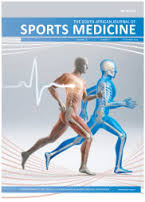Sport supplement use among high school rugby players in South Africa: A scoping review
DOI:
https://doi.org/10.17159/2078-516X/2022/v34i1a13348Abstract
Background: The use of sport supplements has increased for all types and levels of sport, with an estimated increase of 5.8% annually. Sport supplement usage and doping among high school athletes has increased over the years to meet the demands of the sports.
Objective: This scoping review identifies the trends and gaps in current literature regarding sport supplement use among high school rugby players in South Africa.
Methods: A search was conducted using six electronic databases, namely Oxford Academic, Emerald Publishing, ResearchGate, SABINET, PubMed and Google Scholar. The eligibility of the articles was determined by means of a PRISMA flow diagram with the following inclusion criteria: (1) research concerning supplement use among rugby players, (2) research concerning supplement use among high school rugby players. Five articles all comprising of cross-sectional study designs were included in this scoping review.
Results: The prevalence of sport supplement use among adolescent rugby players ranged from 30% to 45%. Protein supplements (31% – 79%) were the most commonly identified supplement used among adolescent rugby players with the aim to improve sport performance as the most common reason for use. The internet (74%) and magazines (72%), followed by coaches comments (28% to 30%), were given as the most common sources of information.
Conclusion: The use of sport supplements is increasing among high school athletes due to the belief that these substances will provide sporting performance benefits or enhance the competitive ‘edge’ of these athletes. Additional education regarding the safety of supplements is necessary to lower the incidences of doping among young athletes and avoid the adverse health effects that uncontrolled supplement use can cause.
Downloads
Downloads
Published
Issue
Section
License
Copyright (c) 2022 South African Journal of Sports Medicine

This work is licensed under a Creative Commons Attribution 4.0 International License.
The South African Journal of Sports Medicine reserves copyright of the material published. The work is licensed under a Creative Commons Attribution 4.0 (CC BY 4.0) International License. Material submitted for publication in the South African Journal of Sports Medicine is accepted provided it has not been published elsewhere. The South African Journal of Sports Medicine does not hold itself responsible for statements made by the authors.
How to Cite
- Abstract 985
- PDF 625






.png)